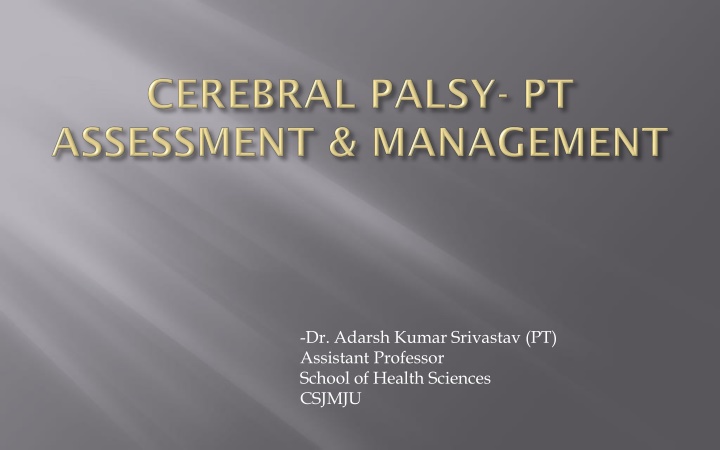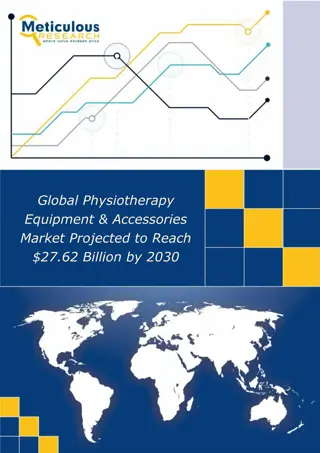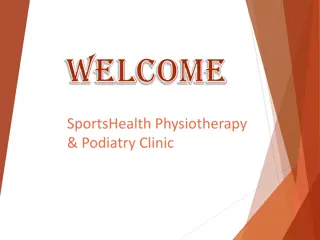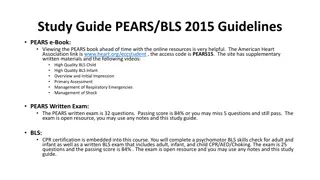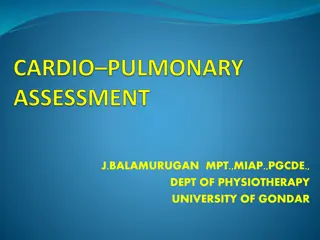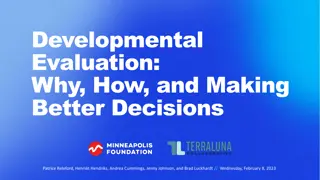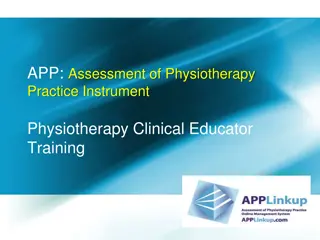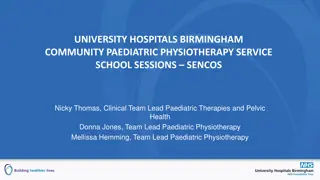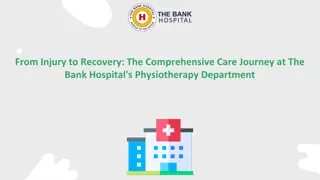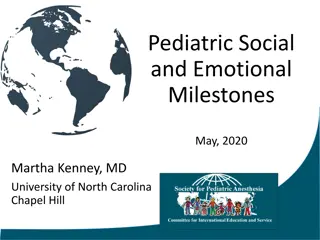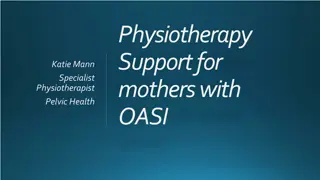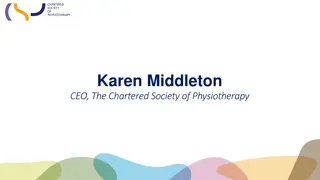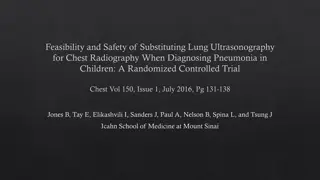Comprehensive Developmental Assessment Process in Pediatric Physiotherapy
This detailed guide covers the subjective examination, history review, prenatal history, perinatal history, postnatal history, and behavioral assessment of children for a comprehensive developmental assessment. It includes aspects such as parental observations, pregnancy complications, birth details, maternal health history, and the child's early life experiences. The information gathered helps in understanding the child's developmental journey and guides therapeutic interventions for optimal growth and function.
Download Presentation

Please find below an Image/Link to download the presentation.
The content on the website is provided AS IS for your information and personal use only. It may not be sold, licensed, or shared on other websites without obtaining consent from the author.If you encounter any issues during the download, it is possible that the publisher has removed the file from their server.
You are allowed to download the files provided on this website for personal or commercial use, subject to the condition that they are used lawfully. All files are the property of their respective owners.
The content on the website is provided AS IS for your information and personal use only. It may not be sold, licensed, or shared on other websites without obtaining consent from the author.
E N D
Presentation Transcript
-Dr. Adarsh Kumar Srivastav (PT) Assistant Professor School of Health Sciences CSJMJU
Subjective Examination: Obtained from parents especially mother or from relatives and through case-sheet. General details includes Name Age & Sex Address When did the mother first noticed the dysfunctions Siblings having same type of symptoms
History Review of complications of pregnancy & delivery, birth weight, gestation, any neonatal & perinatal difficulties, feeding problems, and other health- related problems Developmental milestones
Prenatal History Age of mother Consanguity marriage Any drugs taken during pregnancy Any trauma & stress Any addiction smoking or alcoholism History of TORCH infection History of previous abortions, still born or death after birth Multiple pregnancies Status & cast of the mother
Perinatal History Place of delivery History preterm or post-term delivery History of asphyxia at birth History of prolonged labour pain Type of delivery (Forceps, vacuum delivery) Presentation of child (Breech) Condition of mother at the time of delivery
Postnatal History Delayed birth cry Weight of the child at birth History of trauma to brain during the first 2 years of life History of neonatal meningitis, jaundice, hypoglycemia, Hydrocephalus or Microcephaly Nutritional habits of the child (malnutrition), Feeding difficulties Any medical, surgical or physiotherapy treatment taken before What treatment was used? Was the treatment effective or not? What was the ability level of child at that time? What obstructs the child from progress? Apgar Score from the case-sheet
Behaviour of the child Whether child is alert, irritable or fearful in the session or during particular activities Child becomes fatigued easily or not during activity What motivates his action particular situation, person or special plaything Communication of the child With the parents Whether child initiates or responds with gestures, sounds, hand or finger pointing, eye pointing or uses words and speech
Other observations Involuntary movements Deformities & contracture Scar may be present Trophic changes may also be seen due to poor positioning Postural faults Gait abnormalities Use of external appliances
Attention span What catches child s attention For how much time child s attention is maintained on particular thing How does parent assist him to maintain attention What distracts the child Does child follows suggestions to move or promptings to act
Position of the child Which position does the child prefer to be in? Can child get into that position on his own or with help? With assistance, child makes any effort to go in that position Symmetry of the child (actively or passively maintained) If involuntary movements present, then in which positions these movements are decreased or increased
Postural control & alignment How much parental support is given Postural stabilization and counterpoising in all postures Proper & equal weight bearing If the child s center of gravity appears to be unusually high, resulting in floating legs and poor ability to raise head against gravity Fear of fall in child due to poor balance
Use of limbs & hands Limb patterns in changing or going into position as well as using them in position Attitudes of limbs during playing & in all positions Whether one or both hands are used, type of grasp and release Accuracy of reach and hand actions Any involuntary movements, tremors or spasms, which interfere with actions, are present
Sensory aspects Observe child s use of vision, hearing, of touch, smell and temperature in relevant tasks Does child enjoys particular sensations Whether child enjoys being moved or having position changed Form of Locomotion How child is carried Any use of wheelchair or walking aids Which daily activities motivates child to roll, creep, crawl, bottom shuffle or walk
Deformities Any part of body, which remains in particular position in all postures & in the movements The positional preferences typically seen in spastic cerebral palsies are for mid positions of body In the UL Shoulder protraction or retraction, adduction and internal rotation, Elbow flexion, Forearm pronation, Wrist & Fingers flexion In the LL Hip semi-flexion, internal rotation and adduction, Knee semi-flexion, Ankle plantar flexion, Foot pronation or supination, Toes flexion Athetoid or dystonic posturing usually incorporates extremes of movement such as total flexion or extension Windswept Deformity of hip One hip flexed, abducted and externally rotated; other hip flexed, adducted and internally rotated and in danger of posterior dislocation
Higher cognitive function Drowsy & lethargic Decrease in intellectual function Mental retardation (mild to profound) Attention deficit & easily distractible Poor memory Poor comprehension of speech & language
Cranial nerve integrity Strabismus or squint (Occulo motor nerve) Visual defects (optic nerve) Auditory defects (auditory nerve) Feeding & swallowing problems (lower cranial nerves) etc.
Special senses Visual & auditory defects Tactile & vestibular hyposensitivity or hypersensitivity
Sensory Assessment It is difficult to assess sensation in babies and young children with severe multiple impairments. If any hearing or visual or psychological abnormalities are present then assessment done by specialist is required
Motor integrity Abnormalities of tone Spasticity, hypotonicity, dystonia etc Muscular weakness Loss of voluntary control Decreased co ordination
Reflex integrity Abnormal DTR Abnormal Superficial reflexes Abnormal primitive reflexes may be persistent ATNR, Extensor thrust, gallant reflex etc
ROM & flexibility Decreased in the ROM of the involved limbs Tightness & contracture in hip adductors, hamstrings, calf are very common
Anthropometric measurement Height or length decreased (growth retardation) Weight decreased (thin & lean) or obese Head circumference decreased (growth retardation or microcephaly), increased (hydrocephalus)
Growth Parameters Height - Until 24 to 36 months of age, length in recumbency is measured using an infantometer. After the age of 2 years standing height is recorded by a stadiometer Weight At birth 3-6 months 1-6 yrs 7-12 yrs kg 3.25 Age in months +9/2 Age in years x 2 + 8 [(age in yrs x 7) + 5] /2 Pounds 7 Age in months + 11 (Age in yrs x 5)+17 Age in years x 7 + 5
Weight Weight kg Pounds At birth 3.25 7 3-6 months Age in months +9/2 Age in months + 11 1-6 yrs Age in years x 2 + 8 (Age in yrs x 5)+17 7-12 yrs [(age in yrs x 7) + 5] /2 Age in years x 7 + 5
Head circumference of the child - The tape is used to measure occipitofrontal head circumference from external occipital protuberance to glabella Head cicumference At birth 3 months 1 yr 2 yrs 12 yrs Cm 35 40 45 48 52
Developmental milestones Age 4 to 6 weeks 3 months 6 months 7 months 5 to 6 months 6 to 7 months 6 to 7 months 8 to 10 months Developmental Milestones Social smile Head holding Sits with support Sits without support Reaches out for bright object & gets it Transfers object from one hand to other Starts imitating cough Crawls
10 to 11 months 9 months 12 months 10 to 11 months 13 months 12 months 13 months 15 to 18 months Creeps Standing holding furniture Walks holding furniture Stands without support Walks without much of a support Says one word with meaning Says three words with meaning Joints 2 or 3 words into sentence
13 months 15 to 18 months 15 to 18 months 24 months 24 months 3 to 4 years 2 years 3 years 3 years 3 years Feeds self with spoon Climbs stair Takes shoes and socks off Puts shoes and socks on Takes some clothes off Dresses self fully Dry by day Dry by night Knows full name and sex Rides tricycle
Joint Range of Motion (active & passive) Active head and trunk flexion, extension, rotation observed during head raise in prone, supine, sitting, standing developmental channels Active shoulder elevation, abduction, rotation, flexion and extension movements are observed during functional examination of creeping, reaching and other arm movements Active elbow flexion and extension observed during child s reach to parts of body or toys Active wrist and hand movements will be observed during function development Active hip flexion and extension will be observed during all functions Active knee flexion and extension seen with active hip flexion extension Foot movements are also check during functional development
Posture Poor posture in all types of CP Kypho-Scoliosis, knock knee & flexion deformity & inverted flat foot are commonly seen
Balance & gait Compromised static & dynamic balance Balance severely affected in athetoid & ataxic CP Independent walking is rarely achieved by spastic quadriplegic & athetoid CP, few diplegic CP can walk with aids, hemiplegic CP can achieve independent walking
Bowel & bladder involvement If the child is able to communicate & understand, training can be helpful In profound MR and those unable to communicate have dependent functions
Functional capacity Varies from complete dependence to complete independent
Family education Handling & care Promote infant & parent interaction Encourage development of functional skills & play Promote sensory motor development Establish head & neck control Attain & maintain upright position
Educate families about CP Provide support in their acceptance of child Goal setting & programming should be done with family Be realistic about the prognosis & efficacy of PT while remaining hopeful Honesty & commitment towards child Listening to parental concerns & recognizing personal values & strength
Promote parents ease, skill & confidence in handling child Positioning, feeding & carrying techniques should be taught Promote symmetry, limit abnormal posturing & facilitate functional motor activity Use variety of movement & posture to promote sensory function Include position to allow lengthening of spastic or hypoextensive muscles Use positions to improve functional voluntary movement of limbs
Activities should be done on mother's lap, close to body & face so that her touch & stroking & talking to baby not only help motor development but also body image, movement enjoyment by baby & demonstrate love & security Weaning of child to a PT should be carefully done after mother-child bonding & confidence is established
Introducing more than one therapist or developmental worker may be disconcerting to child & even parents Not to overload with exercises, but rather use corrective movements & postures within ADL of child
respiration Position in a propped up sitting for feeding For greater hip stability & symmetry during feeding position in a high chair with adaptation Head & neck position should be in neutral rotation & slight flexion to facilitate swallowing Deep respiration can be facilitated before feeding by applying pressure in the thorax or the abdominal area
Reaching, rolling, sitting, crawling & transitional movements like standing & pre walking are facilitated Promotes spatial perception, body awareness & mobility, facilitate play, social interaction & exploration of environment Use of equipments that facilitates function when impairment is preventing development E.g. sitting on adapted chair
Practice midline play, reach for feet, suck on fingers Do not give too many stimuli at once Carefully introduce different surfaces for child to roll on, creep, crawl, & walk on with bare feet Always give child time to experience tactile & auditory stimuli & let him reach & find out about himself whenever possible
vestibular function They are compensatory stimuli for visual impairment & also develop body image Touch, pressure & resistance can be correctly given to stimulate movement giving clues as to direction & degree of muscle action. Do not use Rx with handling or other proprioceptive stimuli from behind as leaning back will facilitate extensor thrusts
Can be easily integrated with methods for head control, hand function & all balance & locomotor activities Relate appropriate level of visual ability with child's motor programme. Also one may have to accept unusual head position & other patterns which make it possible for the child to use residual vision Use favorite toys or colors to facilitate visual function
Talk & clearly label body parts used Delay is normal for a child who cannot yet understand meaning of sounds, words & conversation Use simple & easy words with appropriate examples & models Communication is also fostered through motor actions, touch & body language relevant to sign system of a child
Postural stability of the head when lying prone (0-3 months) on forearms (3 months) on hands and on hands and knees (6 months), during crawling, half-kneeling hand support (9-11 months) in the bear-walk (12 months) in normal developmental levels.
Acceptance of prone position. Accustom child to prone on soft surfaces, sponge rubber, inflatable mattress, in warm water, over large soft ball, over your lap rock and sway a baby held in prone suspension.
Postural stability of the shoulder girdle weight on forearms (3 months), on hands (6 months), on hands & knees & arms held stretched forward along the ground to hold a toy at 5-6 months also include postural stability. Pivot prone with arms held extended in air activates stabilizers (8-10 months). Maintenance of half-kneeling lean or upright kneeling (lean on hands) or grasp a support - 9-12 months stimulates shoulder girdle stability
Postural stability of pelvis On knees with hips at right angles (4 months) on elbows & knees & on hands and knees (4-6 months), on half-kneeling and upright kneeling with support (9-12 months) in normal motor levels.
